Chiari Fact #16

As discussed in our last fact on Syringomyelia, syrinxes (syringes) are caused by a blockage of cerebrospinal fluid (such as is seen with a Chiari Malformation). When the brainstem is also herniated (like it is with a Chiari 1.5, which we will discuss later this month), it makes the brainstem even more susceptible to a syrinx within the medulla oblongata (the lowest part of the brainstem). When a syrinx forms in or reaches up to the brainstem, it is known as Syringobulbia. This line between the medulla and the spinal cord is called the Cervicomedullary Junction.
The severity of symptoms depends on how much of the medulla is damaged by the syrinx. Symptoms of Syringobulbia are much different than those associated with the Syringomyelia because the function of the brainstem (especially the medulla oblongata) is much different than that of the spinal cord. The medulla controls the Autonomic Nervous System (which controls most of the actions that happen automatically – without requiring cognitive thought). Symptoms associated with Syringobulbia are what are generally called Dysautonomia.
For more information on Medullary Injury and Dysautonomia: http://www.dysautonomiainternational.org/page.php?ID=122

